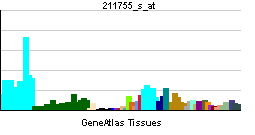ATP5F1
| ATP synthase, H+ transporting, mitochondrial F0 complex, subunit B1 | |||||||||||
|---|---|---|---|---|---|---|---|---|---|---|---|
| Identifiers | |||||||||||
| Symbols | ATP5F1 ; MGC24431; PIG47 | ||||||||||
| External IDs | Template:OMIM5 Template:MGI HomoloGene: 1275 | ||||||||||
| |||||||||||
| RNA expression pattern | |||||||||||
 | |||||||||||
| More reference expression data | |||||||||||
| Orthologs | |||||||||||
| Template:GNF Ortholog box | |||||||||||
| Species | Human | Mouse | |||||||||
| Entrez | n/a | n/a | |||||||||
| Ensembl | n/a | n/a | |||||||||
| UniProt | n/a | n/a | |||||||||
| RefSeq (mRNA) | n/a | n/a | |||||||||
| RefSeq (protein) | n/a | n/a | |||||||||
| Location (UCSC) | n/a | n/a | |||||||||
| PubMed search | n/a | n/a | |||||||||
ATP synthase, H+ transporting, mitochondrial F0 complex, subunit B1, also known as ATP5F1, is a human gene.[1]
This gene encodes a subunit of mitochondrial ATP synthase. Mitochondrial ATP synthase catalyzes ATP synthesis, utilizing an electrochemical gradient of protons across the inner membrane during oxidative phosphorylation. ATP synthase is composed of two linked multi-subunit complexes: the soluble catalytic core, F1, and the membrane-spanning component, Fo, comprising the proton channel. The catalytic portion of mitochondrial ATP synthase consists of 5 different subunits (alpha, beta, gamma, delta, and epsilon) assembled with a stoichiometry of 3 alpha, 3 beta, and a single representative of the other 3. The proton channel seems to have nine subunits (a, b, c, d, e, f, g, F6 and 8). This gene encodes the b subunit of the proton channel.[1]
References
Further reading
- Higuti T, Tsurumi C, Osaka F; et al. (1991). "Molecular cloning of cDNA for the import precursor of human subunit B of H(+)-ATP synthase in mitochondria". Biochem. Biophys. Res. Commun. 178 (3): 1014–20. PMID 1831354.
- Gay NJ, Walker JE (1986). "Two genes encoding the bovine mitochondrial ATP synthase proteolipid specify precursors with different import sequences and are expressed in a tissue-specific manner". EMBO J. 4 (13A): 3519–24. PMID 2868890.
- Farrell LB, Nagley P (1987). "Human liver cDNA clones encoding proteolipid subunit 9 of the mitochondrial ATPase complex". Biochem. Biophys. Res. Commun. 144 (3): 1257–64. PMID 2883974.
- Houstĕk J, Andersson U, Tvrdík P; et al. (1995). "The expression of subunit c correlates with and thus may limit the biosynthesis of the mitochondrial F0F1-ATPase in brown adipose tissue". J. Biol. Chem. 270 (13): 7689–94. PMID 7706317.
- Maruyama K, Sugano S (1994). "Oligo-capping: a simple method to replace the cap structure of eukaryotic mRNAs with oligoribonucleotides". Gene. 138 (1–2): 171–4. PMID 8125298.
- Suzuki Y, Yoshitomo-Nakagawa K, Maruyama K; et al. (1997). "Construction and characterization of a full length-enriched and a 5'-end-enriched cDNA library". Gene. 200 (1–2): 149–56. PMID 9373149.
- Elston T, Wang H, Oster G (1998). "Energy transduction in ATP synthase". Nature. 391 (6666): 510–3. doi:10.1038/35185. PMID 9461222.
- Wang H, Oster G (1998). "Energy transduction in the F1 motor of ATP synthase". Nature. 396 (6708): 279–82. doi:10.1038/24409. PMID 9834036.
- Jia L, Young MF, Powell J; et al. (2002). "Gene expression profile of human bone marrow stromal cells: high-throughput expressed sequence tag sequencing analysis". Genomics. 79 (1): 7–17. doi:10.1006/geno.2001.6683. PMID 11827452.
- Strausberg RL, Feingold EA, Grouse LH; et al. (2003). "Generation and initial analysis of more than 15,000 full-length human and mouse cDNA sequences". Proc. Natl. Acad. Sci. U.S.A. 99 (26): 16899–903. doi:10.1073/pnas.242603899. PMID 12477932.
- Cross RL (2004). "Molecular motors: turning the ATP motor". Nature. 427 (6973): 407–8. doi:10.1038/427407b. PMID 14749816.
- Gerhard DS, Wagner L, Feingold EA; et al. (2004). "The status, quality, and expansion of the NIH full-length cDNA project: the Mammalian Gene Collection (MGC)". Genome Res. 14 (10B): 2121–7. doi:10.1101/gr.2596504. PMID 15489334.
- Gregory SG, Barlow KF, McLay KE; et al. (2006). "The DNA sequence and biological annotation of human chromosome 1". Nature. 441 (7091): 315–21. doi:10.1038/nature04727. PMID 16710414.
- Ewing RM, Chu P, Elisma F; et al. (2007). "Large-scale mapping of human protein-protein interactions by mass spectrometry". Mol. Syst. Biol. 3: 89. doi:10.1038/msb4100134. PMID 17353931.
| This protein-related article is a stub. You can help Wikipedia by expanding it. |